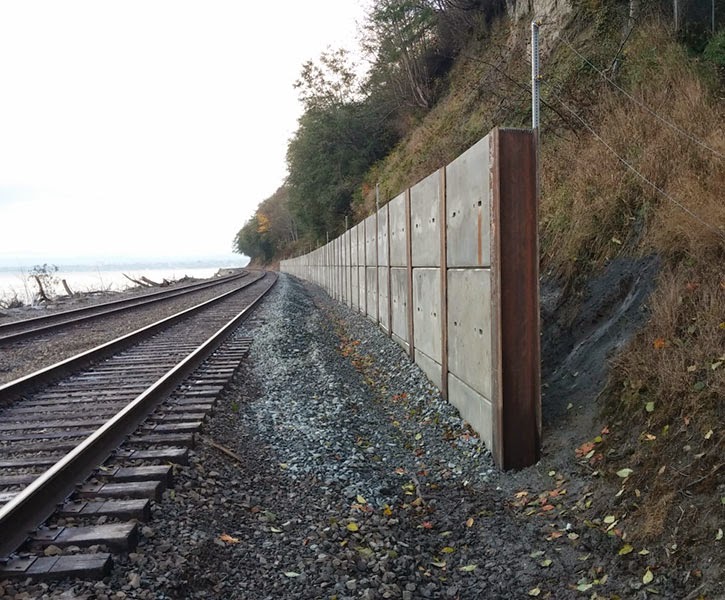What we’re doing to prevent landslides near rail lines
Posted by Unknown in Amtrak Cascades, gravity, landslide, mudslide, passenger train, rail, rain on Friday, January 2, 2015
By Barbara LaBoe
You can’t fight Mother Nature. But when it comes to landslides that block rail lines north of Seattle, we’re trying to call a truce.
 |
| This 1997 Department of Ecology picture of a landslide near Woodway, WA shows how devastating slides can be to property and rail lines. |
BNSF Railway Company owns and operates the railway. For each landslide on the north rail line, BNSF sets a minimum 48-hour moratorium on passenger rail service between Seattle and Everett. During that time, BNSF clears debris, repairs the tracks and checks the slope. While moratoriums are in effect, buses transport our Amtrak Cascades passengers between the Seattle and Everett stations to continue their train journeys.
We manage the Amtrak Cascades passenger rail service along with the Oregon Department of Transportation. Amtrak operates the service for the two states. So we take train safety and landslide disruptions seriously.
 |
| Retaining walls, like this one, help catch and contain landslide debris before it can reach the tracks. |
We also, along with other work group members, held three educational open houses in communities along the north rail line to allow landowners to learn about landslide risks and prevention on their property. We met with mayors and city councils this year in Mukilteo, Edmonds and Everett about the issue. And a brochure with information and prevention tips (pdf 340 kb) was mailed to landowners along the affected rail corridor. In some cases, preventive measures are simple, such as planting native vegetation to prevent erosion and reduce the risk of landslides. New or reworked drainage systems also can help stabilize the slope and safeguard property -- as well as the rail lines. As part of this process, BNSF also agreed to waive permit fees through April 2015 for landowners who connect to the railroad’s drainage system.
- Retaining walls to catch landslide debris before it hits the tracks.
- Slide detection fences to give early warnings of active landslides.
- Improved drainage systems.
- Erosion control.
Two of the projects, one south of Mukilteo and another near Everett, were constructed this year. A third may be constructed in 2015. For the other three projects, funding is being explored.
 |
| Stabilizing land and reducing the steepness of a slope, as shown here near Mukilteo, can also help prevent landslides. |
Of course, there’s never a 100 percent guarantee when you’re dealing with landslides. But by addressing landslide risks and prevention head-on, we hope to reduce at least some of Mother Nature’s impact.
This entry was posted on Friday, January 2, 2015 at 11:05 AM and is filed under Amtrak Cascades, gravity, landslide, mudslide, passenger train, rail, rain. You can follow any responses to this entry through the RSS 2.0. You can leave a response.







# by FenixSEO - October 8, 2017 at 3:05 AM
Hi fellas,
Thank you so much for this wonderful article really!
If someone want to read more about that permanent make up lynnwood I think this is the right place for you!